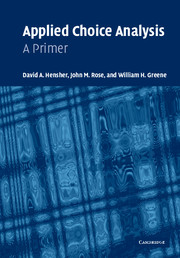Book contents
- Frontmatter
- Contents
- List of figures
- List of tables
- Preface
- Part I Basic topics
- 1 In the beginning
- 2 Basic notions of statistics
- 3 Choosing
- 4 Paradigms of choice data
- 5 Processes in setting up stated choice experiments
- 6 Choices in data collection
- 7 NLOGIT for applied choice analysis: a primer
- 8 Handling choice data
- 9 Case study: mode-choice data
- 10 Getting started modeling: the basic MNL model
- 11 Getting more from your model
- 12 Practical issues in the application of choice models
- Part II Advanced topics
- Glossary
- References
- Index
6 - Choices in data collection
Published online by Cambridge University Press: 05 September 2012
- Frontmatter
- Contents
- List of figures
- List of tables
- Preface
- Part I Basic topics
- 1 In the beginning
- 2 Basic notions of statistics
- 3 Choosing
- 4 Paradigms of choice data
- 5 Processes in setting up stated choice experiments
- 6 Choices in data collection
- 7 NLOGIT for applied choice analysis: a primer
- 8 Handling choice data
- 9 Case study: mode-choice data
- 10 Getting started modeling: the basic MNL model
- 11 Getting more from your model
- 12 Practical issues in the application of choice models
- Part II Advanced topics
- Glossary
- References
- Index
Summary
USA Today has come out with a new survey – apparently, three out of every four people make up 75 percent of the population.
(David Letterman, 1947–)Introduction
To estimate a statistical model one requires data. To estimate a statistical model of choice, one requires choice data. Chapters 4 and 5 provided the reader with an understanding of the data requirements for modeling choice. But having an understanding of the theoretical requirements is one thing. How do we gather choice data in practice?
While this chapter is devoted to questionnaire construction, we remind the reader that the overall purpose of this book is to educate on matters related to choice modeling. We therefore offer only limited discussion on general questionnaire construction and reiterate that, should the reader seek a greater understanding of questionnaire construction beyond the bounds of choice, they seek information elsewhere (some specific texts on questionnaire construction include Foddy 1994; Dillman 2000, a book the authors recommend be on any self-respecting researcher's bookshelf; Frazer and Lawley 2000).
General survey instrument construction
The writing of questionnaires for the collection of choice data are an in-depth process that adds to the already existing complexities of more traditional questionnaire construction. While the analyst must adhere to the well-documented conventions of questionnaire construction, added burdens (as we will show) associated with the collection of choice data also require consideration. Yet, as with any survey, the more time spent in preparation, the less problems are likely to occur, problems which the analyst may not be able to rectify at a later stage of the research project.
- Type
- Chapter
- Information
- Applied Choice AnalysisA Primer, pp. 161 - 196Publisher: Cambridge University PressPrint publication year: 2005



